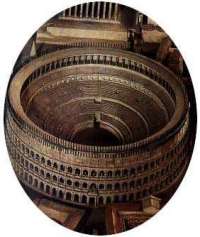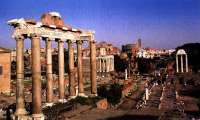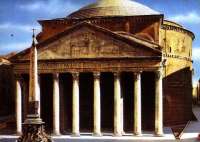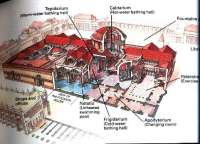
Words inherited from Latin in the field of Architecture and Techniques

Examples and pictures
-amfiteatru:
initially it designated a building designed for public games, having a round or oval shape, roofless, with an arena in the centre surrounded by circles and steps for the public; its meaning was enriched, coming to mean a lecture or theater hall with terrased seats or set on an inclined plane:
-apeduct: its meaning has stayed the same- a group of buildings and installations used to the transportation of the water from its source to the place of usage. The first aqueduct, Aqua Appia was an underground one, 16km. Long, built during the administration of Appius Claudius Caecus. The first aqueduct outside, Aqua Marcian in Rome, was 90km long and was built by the praetor Marcius in 144 B.C. -for: initially
it meant the public market where the social, political, religious and economic life was concentrated; there trials were judged; the present meaning is that of authority, instance or state body- the big Forum in
Rome (Forum Romanum Magnum); the forums of Vespasian, the forum started by Domitian and completed by Marcus Cocceius Nerva; the forum of Trajan with the basilica Ulpia and Trajan's column; all communicated with the
Big Roman Forum.
-temple: the meaning has been preserved- an edifice destined to the worshipping of gods; the Pantheon, a temple built to the gods of Olympus between 27-25 B.C. by
Vespasianus Agrippa, became famous under this Greek name that means "dedicated to all the gods". Some other temples: Saturn's Temple, Divus Iulius's Temple Castor and Pollux's Temple, Vesta's Temple.
-terme: Roman public baths, Today the term is used for thermal waters, eg. Hadrian's therms, Caracalla's therms.
the one in Sarmisegetusa held 12,000 spectators; even more it can mean the terrased configuration of some hilly or mountainous areas. The first amphitheater was built in 59 B.C. by Gaius Scribonius Curio( the
pontifex maximum-the highest priest in Rome). Colosseum, its real name being the Flavian amphitheater, which was used for the fights between gladiators was built by the emperor Vespasian. Some other amphitheaters
can be found in the Italian towns Pazzuoli, Capua, Verona, Tarragona.
Some modern aqueducts are Kaiser Franz Joseph in Vienna 232km long; the one in Delaware 137km; the one providing Glasgow with water 56km; and Liverpool 109km.




